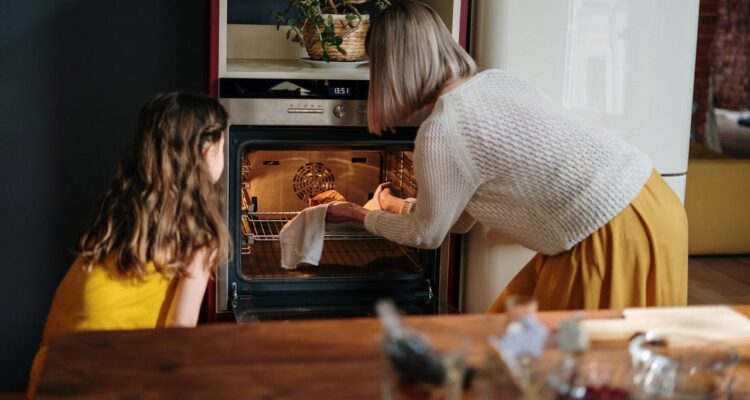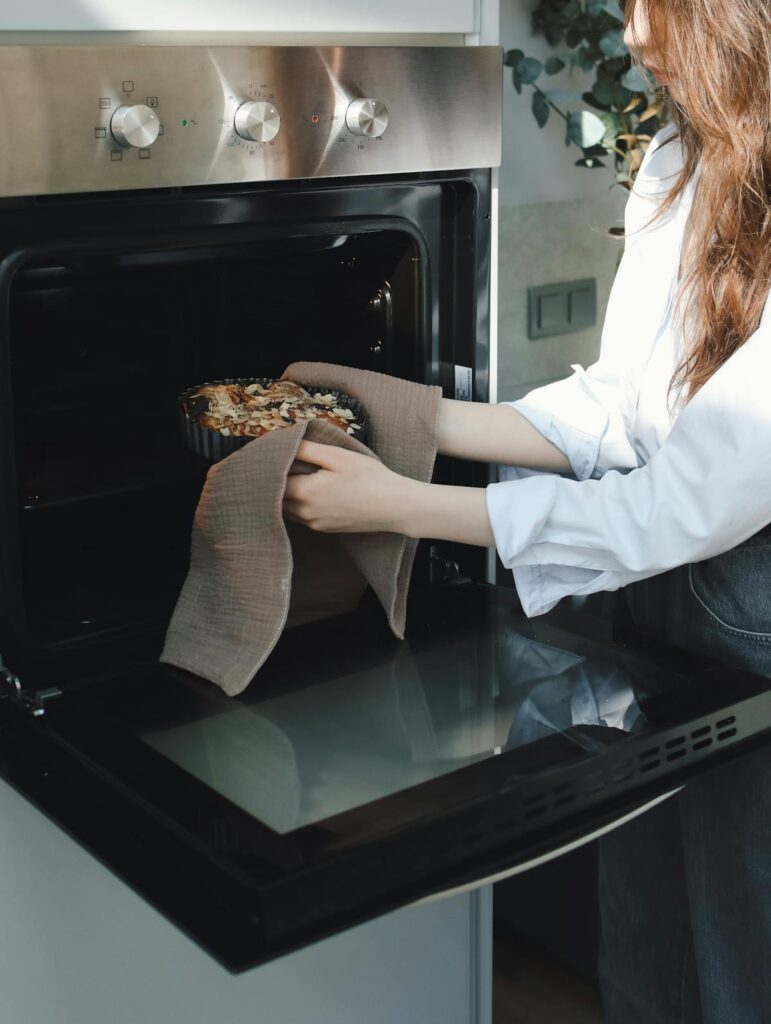We get it, you had ‘crispy’ in mind, not flashing lights and sirens. But even the most seasoned home cooks can get caught off guard when things heat up unexpectedly.
Fires start fast, and they don’t wait for you to Google what to do. That’s why a little prep now can save you a lot of panic later. Whether you’re cooking lasagne or just heating leftovers, this is one guide you’ll want in your back pocket.
Spot the Common Risks
Let’s start with what actually causes oven fires, because most of the time, it’s not as dramatic as you’d expect.
Although those oily spills may seem harmless, grease is usually the biggest culprit behind oven fires. If you regularly cook fatty foods and skip the clean-up, residue will build up fast.
Worse yet, that gunk doesn’t just sit there making your kitchen look neglected. Over time, it can turn into a serious fire risk.
Then, there are bubbling sauces, drippy cheese, and wayward crumbs. Left on hot surfaces, they can start smoking or catch on fire if you’re unlucky. Wiping them up as you go might not be fun, but it’s a whole lot easier than dealing with a burnt oven.
Sometimes, though, it’s not about food at all. Worn-out door seals, dodgy temperature controls, or failing parts can cause your oven to overheat. You might not notice these subtle faults until something starts smelling suspicious, but a routine check-up can help you catch them early.
And let’s not forget cookware. Some beautiful-looking glass or metal dishes just aren’t made for high heat. If they’re not oven-safe, they can crack, warp, or release chemicals when things get too hot, and that’s a risk you don’t want.
Cut the Power, Not Corners
If you spot flames inside the oven, try not to panic. Whatever you do, don’t fling the door open to check. That rush of oxygen will feed the fire, not stop it, making things escalate from a small flame to full-blown chaos in seconds.
Instead, turn off the unit immediately and keep the door firmly shut. Without additional oxygen, small fires typically burn out on their own within minutes.
But if the flames get bigger or smoke starts filling the room, it’s time to act. If you have a fire extinguisher nearby and know how to use it, grab it. You should also open the windows to improve ventilation.
On the other hand, if the fire keeps growing or you’re unsure what to do, don’t try to be the hero. Just get everyone out and call emergency services. Yes, your fancy mixer is expensive, but it’s not worth your life.
Master the PASS Method
If you don’t already have a fire extinguisher in the kitchen, now is the time to get one. We recommend going for a Class K model, since it’s made for cooking fires and won’t make things worse.
In the heat of the moment, you don’t want to be reading labels. So, remember these four steps (PASS): pull, aim, squeeze, and sweep. Pull the pin, aim at the base of the flames, squeeze the handle, and sweep side to side until the fire is out or you’ve run out of foam.
Stay at a safe distance while you do it, and never try to fight flames with water. That’s a one-way ticket to flare-ups, especially if grease or electricity is involved.
However, if things don’t settle quickly, don’t push your luck. Get out, stay out, and call in the pros. Extinguishers are for stopping small fires, not containing full-blown blazes.
Call for Help
Sometimes, fires move faster than lightning, and even your best solo efforts won’t cut it. Trusting your instincts about when to back away could save your life.
For example, if the flames peek out from the oven’s edges, dark smoke starts billowing, or the blaze just keeps growing, that’s your cue to leave.
The moment you’re safely outside, dial emergency services. Paint them a clear picture by telling them about any propane tanks or flammable items near the kitchen, whether you have pets inside, and what you have already tried.
The more they know, the better equipped they will be when they arrive. Remember, there’s no shame in calling for backup. Firefighters are trained for exactly these emergencies, and your safety should always come first.
Stay One Step Ahead
A lot of oven fires aren’t freak accidents. In fact, you can prevent most flare-ups and keep your kitchen safe by sticking to a few important habits.
First off, to stop buildup that could catch fire, wipe away grease, crumbs, and spills after each use.
Every few months, call in a deep clean oven service. They’ve got the tools and know-how to remove stubborn carbon and grease without damaging your oven’s delicate parts.
Good airflow matters, too. If your oven is packed to the brim, heat can’t circulate properly, and that means hot spots and a higher chance of overheating.
Speaking of overheating, always choose safe cookware since some materials can warp, crack, or even release fumes when exposed to high heat.
And don’t underestimate the power of a good timer. One beep can save you from clouds of smoke and a kitchen that smells like a bonfire for days.
Create a Safety Plan
You don’t want to be figuring things out while your oven is on fire. That’s why having a plan matters. Start by getting everyone in the same room and talk through a few ‘what if’ scenarios to figure out who should do what if things go sideways.
For example, teens can help their younger siblings, while adults can deal with the power, gas, or pets. The point isn’t to scare anyone. It’s to keep chaos to a minimum if an emergency hits.
Run a few practice drills, and switch up the timing. Try one at night or during dinner and another when everyone’s mid-nap. You’ll spot gaps in your plan fast and build some muscle memory while you’re at it.
Last but not least, pick an outdoor meeting spot that’s far enough from the house to be safe but easy to find. A tree, a streetlight, or even the neighbour’s letterbox works, as long as it’s clear and consistent.
Conclusion
Fires may be fast, but so are you when it counts. Whether it’s a flaming lasagne or just a smoky surprise, you’ve got the tools and smarts to control the situation.
Remember, you don’t need to be fearless. You just need to be ready, and you’re already ahead of the curve just by reading this.


